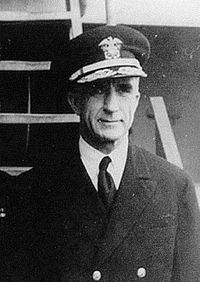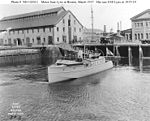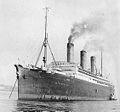- Morton Deyo
-
Morton Lyndholm Deyo 
Born July 1, 1887 Died November, 1973 (aged 85–86) Allegiance United States of America Service/branch United States Navy Rank Vice Admiral Battles/wars Awards Navy Distinguished Service Medal
Legion of Merit (2)Vice Admiral Morton Lyndholm Deyo (1 July 1887 – November 1973) was an officer in the United States Navy, who was a naval gunfire support task force commander of World War II.
Born on 1 July 1887 in Poughkeepsie, New York, he graduated from the United States Naval Academy in 1911, and served over a career of 38 years. His highest Navy rank in active service was Rear Admiral, attaining Vice Admiral at retirement. He was awarded three medals of personal honor, the Distinguished Service Medal (Navy), and the Legion of Merit with Gold Star.[1]
Deyo served in both the Atlantic and Pacific Fleets. In the Atlantic, he commanded the destroyers which provided the first American escort assistance to allied convoys to England just prior to the Japanese attack on Pearl Harbor. He later commanded naval gunfire support at Utah Beach in the Normandy invasion, Task Force 129 at the Bombardment of Cherbourg, as well as during the invasion of Southern France.
When transferred to the Pacific, Rear Admiral Deyo assumed command of Cruiser Division 13 (CruDiv 13). He commanded gunfire and covering force for the assault and occupation of Battle of Okinawa. During the battle, he was the last naval commander to form a battle line with battleships as they prepared to intercept the Japanese battleship Yamato. At the war's end, he accepted the surrender of Japanese forces at Sasebo, Kyushu and directed the Allied Occupational of Western Japan.
Contents
Early Career
Morton Deyo's career ashore meshed with the seagoing responsibilities he would take on at each stage of his career. Training at the U.S. Naval Academy prepared him in engineering and seamanship. He graduated out of the Class of 1911. Most of his academy years were under Superintendent Captain John M. Bowyer at a time of two-year rotations.[2] Deyo then took his first assignment at sea aboard the battleship, USS Virginia.
Caribbean service
Early assignments at sea placed Morton Deyo in the Caribbean. Morton Deyo was aboard the USS Virginia (battleship No. 13) about the time she participated in coaling-at-sea operations. In the years of his service aboard the Virginia, she will take station off Tampico and Vera Cruz, Mexico.[3] In tour a cut short by decommissioning in 1914, the Duncan went to the Caribbean for training, target practice and exercises.[4] In 1914 and 1915, Deyo served aboard USS Washington (Armored Cruiser No. 11) under Captain Edward W. Eberle, commanding. The ship was stationed off of Santo Domingo, Dominican Republic, for diplomatic service, Vera Cruz, Mexico, Cap Haitien, Haiti and returned to Puerto Plata, Dominican Republic, when a crisis recurred there.[5] Deyo’s last tour in the Caribbean before marriage and World War I was aboard the destroyer Jenkins (DD-42). She sailed to Tampico, Mexico and later supported the U.S. occupation of Vera Cruz. Jenkins was assigned patrol operations to search for possible German U-boats.[6] Morton Lyndholm Dayo married Maria Ten Eyck Decatur Mayo in 1916.
As an aide to the Commandant, First Naval District, Boston, 1920-1921 Deyo was a part of an ongoing upgrading of Naval District that would remain in place from 1920 to the outbreak of World War II. The First District absorbed the Second in 1919, and it expanded from a coastal strip to encompass inland states to more nearly correspond to Army districts. The District acquired its own full-time staff, gained new operational functions, and expanded administrative and logistical responsibilities. Proposal for reform of the Naval district regulations were to be revised to embody the lessons of World War I. This is fundamental naval strategy. Mahan had written, "deficient coast protection reacts unfavorably upon the war fleet, which in all its movements should be free from any responsibility for the mere safety of the ports it quits.”[7] Deyo’s next assignment was as an aide to the U.S. military governor at Santo Domingo, Dominican Republic.
Service aboard one ship, and command of another prepared Deyo for duty ashore in a politically and diplomatically sensitive role. In 1914-1915, Deyo served on the USS Washington (armored cruiser, No. 11) during service related to Santo Domingo, Domincan Republic, Vera Cruz, Mexico, and Cape Haitien, Haiti. Capt. Edward W. Eberle, commanding, was active in U.S. attempts to mediate between government and insurgent forces towards a constitutonal government with "observed" elections.[8] When then Lieutenant Commander Deyo had his first command in the USS Morris DD-271, he was attached to the "Adriatic Detachment" performing political and diplomatic duties among nations of the former Austro-Hungarian Empire.[9] In 1921-1923, Deyo served on the staff of the military governor closing out the American occupation of Santo Domingo. The military governor at the time was Warren Harding’s appointment to fulfill his campaign promise to end the Wilson occupation of the Dominican Republic. Rear Adm. Samuel S. Robinson served from 1921. The occupation officially ended July 1, 1924.[10] In 1923 Deyo was assigned to the staff Battleship Fleet, aboard the USS California.
World War I
-

aboard destroyer Allen
escorting troopships
“Sim’s Destroyers” 1916-18
As a part of the new full time staff in the First Naval District, Boston, in 1918, Deyo taught destroyer seamanship. He was assigned the year after Rear Admiral Albert Gleaves, then Commander, Destroyer Force, Atlantic Fleet, became Commander of United States Convoy Operations in the Atlantic in addition to his other duties.[11] He was next transferred to the troopship ‘’Northern Pacific’’ as a part of its regular USN officer complement. World War I movement of a million men and their supplies was unprecedented. The crews of harbor and pilot boats, inshore scouts and patrol craft, new merchantmen, escorting vessels, all required training.[12] In the First Naval District, Deyo was a part of the destroyer piece.
Interwar
1920s Pacific
Deyo was attached to Admiral Samuel S. Robison’s personal staff of ten officers aboard the USS Seattle (CA-11) in 1925-1926. Now a Lieutenant Commander, Deyo was the most junior officer as Flag Lieutenant. The next rung up the ladder was the Assistant Chief of Staff, then Commander Chester W. Nimitz.[13]
Following early armored cruiser service in the Caribbean.[14], World War I destroyer service operating in the North Atlantic.[15], and cruiser service crossing the Pacific.[16], Morton Deyo was assigned to a three-year tour teaching seamanship at the Naval Academy, 1926-1929. He was appointed during the tenure of Superintendent Rear Admiral Lewis M. Nulton and completed his tour under Rear Admiral Samuel S. Robison with whom he served in the Dominican Republic.[17] He returned to sea to take command of destroyer USS Sloat.
His exemplary promise as a commander at sea resulted in an appointment to the Naval War College staff immediately following his study there. He then returned to sea in 1934 as the Executive Officer aboard the light cruiser USS Milwaukee.
1930s Pacific
World War II in the Atlantic
With accumulating experience in escort service in the Atlantic, fleet staff service crossing the Pacific, and Asiatic Squadron staff duty for operations and war plans during Japanese expansion, Deyo was perpared for Main Navy assignments from 1939 to 1941 as the Navy's assistant hydographer, then aide to the Secretary of the Navy until war sent him to sea again.
Then Captain Morton Deyo, was escort commander of Task Unit 4.1.1 and the Commodore of Destroyer Squadron 11..[18] His group was tasked to escort 44 merchant ships ranging from a luxury liner to a rusty ship of the Levant. His pennant Ericsson and the Eberle, were the only modern destroyers in the group. The others were “four-pipers” with “outmoded equipment and low fuel capacity” including the ships of two other squadron commanders.[19] Canadian escorts protected the convoy for the first 350 miles, then the Americans until point “Momp” when the British escorted ships to Britain. Deyo then proceeded with the American destroyers to Iceland with three American merchantmen and one Icelandic.[20]
There was no submarine attack, but the Navy destroyers were inexperienced in their seamanship. They progressed from patrolling only on calm moonlit nights within 1,000 yards of the convoy and staying on station if there was fog, to patrolling 5,000 yards out whatever the sea condition or visibility. U-boat searches were extended to over an hour at a time. Still there was extra work to escorting this convoy. Stragglers, breakdowns and laggards created a ragged formation which was difficult to cordon. The convoy could not sit in the water, so it made numerous course changes to buy time for at-sea overhaul of those falling behind. Nevertheless, when the Nigaristan sank in high winds and rolling seas, the Eberle rescued the entire 63-man crew. On return to the U.S., “Captain Deyo made a number of adversely critical comments in his report” relative to the demands of anti-submarine warfare,” leadership, seamanship and marksmanship.”[21]
On 6 June 1944, now Rear Admiral Deyo commanded the western Operation Neptune Force “U”, supporting the landing of the American First Army at Utah and Omaha beaches.[22]
Deyo commanded Combined Task Force 129 (TF 129), supports General Collins Army VII Corps in taking Cherbourg, France. The American and British ships duel port-city shore batteries and surrounding German defenses. Texas BB-35, destroyers Barton DD722, Laffey DD724, O’Brien DD725 are all damaged by enemy fire.[23]
Naval bombardment for the invasion of Southern France was commanded by Admiral Deyo.[24]World War II in the Pacific
Admiral Deyo's crowning achievement in the Pacific was command of gunfire and covering force for the assault and occupation of Okinawa.[25] It was for service off Okinawa that he was awarded the Navy distinguished service medal.[26]
Rear Admiral Deyo took over Cruiser Division 13 (CruDiv 13) from Rear Admiral Laurance T. DuBose. The Division consisted of four light cruisers - USS Biloxi, USS Birmingham, USS Mobile, and USS Santa Fe.
From 24 March to 4 May 1945, TF 54 under the command of Rear Adm. Deyo commanded battleships, cruisers and destroyers in the bombardment of Kerama Retto and southeast coast of Okinawa, Japan.[27] Following the war, he directed the landing of occupational forces in Northern Japan.[28]
Cold War
Morton Deyo’s last duty station, 1946-1949, was Commandant, First Naval District, Boston. Working out inter-service and inter-department conflicts was a serious goal for the U.S. Navy going into the Cold War. As of September 1945, the qualifications for a district commandant were those of a line officer eligible for command at sea, and the shipyard (specialist) commands were no longer to be held by the same officer. Deyo met the new qualification for District Commandant, and had served at Boston twice before as an instructor and aide to the Commandant during a time of reorganization. Inefficiency from command conflicts were taken under study even before the war ended by the "Farber Committee". The main feature of reform related to the various types of authority over district activities. The Commandant was to have coordinating "military command" over all activities in the district akin to Army districts. The Navy Secretary directed satisfactory relationships.[29] With a background of local relationships, technical expertise, leadership and diplomatic skills, Morton Deyo was the man chosen to make it happen. He retired at the end of his tour with a promotion to Vice Admiral.
Namesake
The destroyer USS Deyo (DD-989) was the 27th Spruance class destroyer and the first ship to be named in honor to Vice Admiral Deyo. She was commissioned on March 22, 1980. The DEYO was last home-ported in Norfolk, Va. Stricken from the Navy list on April 6, 2003, she was sunk as a target on August 25, 2005 in the Atlantic.[30]
Biographical timeline
Milestones[31]
1887, July 1 Born, Poughkeepsie, N.Y.
1916 Married Maria Ten Eyck Decatur Mayo
1949 Retired from navy as vice admiral
1973, Nov. 10 Died, Portsmouth, N.H.Early service
1911 Graduated, United States Naval Academy
1911-1913 Served on Virginia (Battleship)
1913-1914 Served on Duncan (Destroyer)
1914-1915 Served on Washington (Heavy cruiser)
1915-1916 Served on Jenkins (Destroyer)
1916-1918 Served on Allen (Destroyer), Ireland, "Sim's Destroyers"
1918 Trained destroyer crews, First Naval District, Boston, Mass.
1918-1919 Served on Northern Pacific, troop transport, Europe to U.S.
1919 Served on Pretoria (German ship taken over as transport)
Interwar
1919-1920 Commanding Morris (Destroyer), Adriatic, Mediterranean
1920-1921 Aide to commandant, First Naval District, Boston, Mass.
1921-1923 Aide to military governor, Santo Domingo
1923-1925 Staff, Battleship Fleet, California (Flagship)
1925-1926 Staff, U.S. Fleet, Seattle (Flagship)
1926-1929 Instructor in seamanship, U.S. Naval Academy
1929-1930 Commanding Sloat (Destroyer)
1930-1931 Commanding Upshur (Destroyer)
1931-1934 Student, staff, Naval War College, Newport, RI
1934-1936 Executive officer, Milwaukee (Light cruiser)
Pre-war
1936-1939 Operations and war plans, staff, U.S. Asiatic Fleet, Augusta (Flag)
1939-1940 Assistant hydrographer, Navy Department, Washington DC
1940-1941 Aide to Secretary of the Navy, Washington DC
Atlantic
1941 Commanding Destroyer Squadron II, Atlantic, first convoy to Iceland
1942 Commanding Monticello (Auxiliary transport)
1942 Commanding Indianapolis (Heavy cruiser), Aleutians bombardment
1942-1943 Commanding destroyers, Atlantic Fleet
1944 Commanding Ranger Task Group Atlantic
1944 Commanded bombardment, Normandy and southern France, Atlantic
Pacific
1944 Commanded Cruiser Division 13, Task Forces in 3rd and 5th Fleets, Pacific
1945 Commanded Task Force 54, Okinawa campaign, Pacific
Post-war
1945 Commanded Task Forces 55 and 56, surrender, occupation of Japan
1946-1949 Commandant, First Naval District, Boston, Mass.
References
- ^ USS Deyo webpage. DD-989 USS Deyo ship’s history. Viewed 08/08/2011.
- ^ U.S. Naval Academy. About Us: Superintendents Up-to-date listing of U.S. Naval Academy Superintendents. Viewed August 22, 2011.
- ^ Dictionary of American Naval Fighting Ships, Washington-VII
- ^ Dictionary of American Naval Fighting Ships, commissioned 30 Aug 1913|| Duncan-I
- ^ Dictionary of American Naval Fighting Ships, Washington-VII
- ^ Dictionary of American Naval Fighting Ships, Jenkins-I
- ^ Department of the Navy -- Naval Historical Center. Fifty Years of Naval District Development 1903-1953 , The Navy Department Library webpage, viewed 08/17/2011.
- ^ Dictionary of American Naval Fighting Ships, Washington-VII
- ^ Dictionary of American Naval Fighting Ships, Morris-VI
- ^ Pons, Frank Moya., The Dominican Republic: a national history.
- ^ Gill, Charles C., |U.S. Transport Service in the World War reprinted at First World War website, viewed August 18, 2011.
- ^ Department of the Navy -- Naval Historical Center. Fifty Years of Naval District Development 1903-1953 , The Navy Department Library webpage, viewed 08/17/2011.
- ^ Naval Historical Center, |Photo of Admiral Samuel S. Robison, USN, and staff, 1926 Commander-in-Chief, United States Fleet. Members of his personal staff aboard the Fleet flagship, USS Seattle (CA-11), Commencement Bay, Tacoma, Washington, 28 July 1926.
- ^ Dictionary of American Naval Fighting Ships, Washington VII
- ^ Dictionary of American Naval Fighting Ships, Allen-II
- ^ Dictionary of American Naval Fighting Ships, Seattle-I
- ^ U.S. Naval Academy. About Us: Superintendents Up-to-date listing of U.S. Naval Academy Superintendents. Viewed August 22, 2011.
- ^ Cressman, Robert. The official chronology of the U.S. Navy in World War II Naval Institute Press. 1999. ISBN 1-55750-149-1, p.51
- ^ The destroyers in the Task Unit 4.1.1 were Ericsson (pennant comdesron 11), Eberle, Dallas, Upsher (pennant comdesron 30), Upshur, Ellis (pennant comdesron 60). The official designation of the Convoy was HX-150. (Roscoe, 1953, p.35) Ericsson DD440, Eberle DD430, Ellis DD154, Dallas DD199 and Upshur DD144. On Thursday, 18 September 1941 it assumes escort duties for convoy HX 150, 150 miles south of Newfoundland (Cressman, 1999, p.51
- ^ Roscoe, Theodore. United States destroyer operations in World War II, 1953 U.S. Naval Institute ISBN 0-87021-726-7, p.35.
- ^ Roscoe, Theodore. op.cit., p. 35.
- ^ USS Deyo webpage, op.cit.
- ^ Crossman, op.cit., p. 238
- ^ USS Deyo webpage, op.cit.
- ^ USS Deyo webpage, op.cit.
- ^ Military Times (Gannet) http://militarytimes.com/citations-medals-awards/recipient.php?recipientid=27309 Military Times Hall of Valor. Morton Lyndholm Deyo. Date of death, 10 Nov 1973. Retired a Navy Vice Admiral. Navy distinguished service medal. 24 Mar to 4 May 1945, Okinawa campaign.
- ^ Crossman, op.cit., p.305
- ^ USS Deyo webpage, op.cit.
- ^ Department of the Navy -- Naval Historical Center. Fifty Years of Naval District Development 1903-1953 , The Navy Department Library webpage, viewed 08/17/2011.
- ^ USS Deyo webpage, op.cit.
- ^ Kells, Laura J., Morton L. Deyo, A Register of His Papers in the Naval Historical Foundation Collection of the Library of Congress, 2008, p.3 Manuscript Division, Library of Congress
External links
Categories:- 1887 births
- 1973 deaths
- United States Navy admirals
- United States Naval Academy alumni
- Recipients of the Distinguished Service Medal (United States)
- Recipients of the Legion of Merit
Wikimedia Foundation. 2010.

























